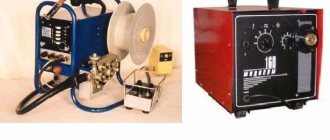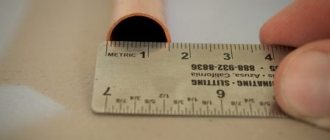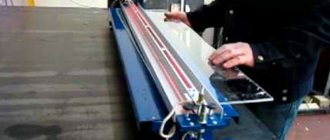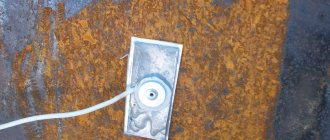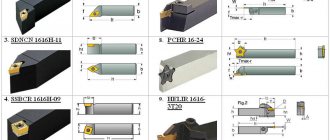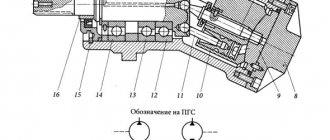Help with advice plz.
Given: Kitchen shelf, solid wood, door opens upward. The door is attached to the body with hinges, the hinges to the door with screws. Screw length – 8-10 mm. One screw “broke the thread” and does not hold. A longer screw does not fit - the door is relatively shallow.
Question: how to reanimate the connection? There is an idea that you need to fill the hole broken by the screw with something and tighten it again. but what exactly is unclear.
The screw popped out of the hinge fastening. MDF doors. You won't be able to change the size of the screw, and you won't be able to move the hinge.
There are several extremely simple ways to do this. The first and requiring skill. This is to wrap the screw in toilet paper, dip it in polymer glue, let it soak a little and tighten it. The downside is that you may not be able to unscrew it later. The second method: take a plastic braid from any round wire that matches the hole in diameter, insert it and twist it. Unlike a dowel, the wiring does not allow you to tear the wood or material into which you screw the screw; it is soft but holds well. You can also use a dowel, you just need to cut off the tendrils. You can also drive a wooden furniture tip and screw it into it.
Respected authors have already given you almost all the practical advice on the question “How to screw a screw into the previous hole?” To all of the above I can only add the following.
- You can wrap a thin wire around the screw directly along the turns of the screw. It will be like a spring. Bite off the ends of this spring, those that extend beyond the length of the threaded part of the screw. Insert this spring into the old hole using epoxy glue, flush with the surface. After drying, you can screw in the screw.
- Another method, less popular but no less interesting. The destroyed hole is filled with epoxy glue and a screw coated with machine oil is inserted into it. After the glue hardens, the screw is unscrewed and a plastic thread is obtained for it.
- It can be more radical, and I think it’s reliable. This is to drill out the old hole for the screw with a larger drill diameter. And place a wooden or plastic liner on the glue. Wait until completely dry. After this, it will definitely need to be pre-drilled with a drill of a smaller diameter than the screw, so that the latter does not split it. This video shows this action more clearly -
Read also: How to correctly test wiring in a car with a multimeter
Threaded connections are the most widely used today. They are used in various industries. During operation, the working part of the thread may be damaged, resulting in reduced strength and reliability. There are quite a large number of different ways to restore a damaged working part, all of them are characterized by their own specific features.
How to unscrew a bolt without a head?
Using an ordinary chisel (of a suitable size), you can carefully, evenly and without haste, unscrew any bolt and do not need to drill anything. Using an ordinary chisel (of a suitable size), you can carefully, evenly and without haste, unscrew any bolt and do not need to drill anything.
Interesting materials:
What are the surnames of Turks? What shapes are considered symmetrical? What films are considered classics? What films were filmed in Pereslavl? What films should you watch on the road? What physical and moral qualities does basketball develop? What form factors are there in SSDs? What fruits for compote? Which fruits ripen on their own? What fruits and vegetables ripen in the fall?
How to restore a thread with a tap
Before restoring a thread with a tap, determine whether it is possible to increase its diameter or cut a new one in a different location. If yes, then the repair will take place very quickly.
- Drill out the hole.
- Cut new thread.
Photo No. 1: tapping threads
When working, observe the following basic rules.
- Drill the hole strictly at a right angle
- Use two new taps of the required diameter (for roughing and finishing).
- Be careful when cutting threads. Avoid distortions and sudden movements.
- It is advisable to cut the thread using a wrench. If you don't have one, take an adjustable wrench.
- Remember to use lubricant and remove chips regularly.
Flaws
There are also some negative aspects, since it is impossible to completely replace real welding. Therefore, only such procedures as thread repair by cold welding and others are carried out here.
- Relatively low strength of the obtained elements;
- Heterogeneity of metal on workpieces and on restored elements;
- Lack of possibility of application at critical facilities;
- Affected by temperature and other environmental factors.
Glue composition
The components included in the adhesive mass are aimed at creating a homogeneous mixture. Plastic properties are created by epoxy resin. It improves the composition and makes it softer and more comfortable to use. To obtain a single solid component with metal, metallic substances are added. During the process of filling and repairing the chip, the polymer welding mass fills the parts that have received a defect.
The quality of the welding mass requires unique properties. They make cold welding common and attractive to consumers with different professional and construction needs. The seam obtained by cold welding will be inferior in some characteristics to the standard method, but will provide advantages in terms of speed of work, conditions and simplicity of the procedure.
Read more: Movies with BMW E34
How to restore a thread with a tap while maintaining its diameter and location
If you need to restore the thread while maintaining its diameter, use one of the following methods.
Welding the hole and then cutting a new thread
This method is rarely used due to the fact that the strength of the new thread obtained using this technology will be lower. This method is also chosen in the absence of special devices (screws and spiral inserts).
This method of thread restoration includes the following steps.
- Removing old threads by drilling.
- Welding the hole. The choice of technologies depends on the materials of the parts.
To weld holes in steel products, electric arc or gas welding is used in protective environments.
- When working with cast iron parts, gas or electric arc welding is used in a cold state or with general/local heating.
- Electrodes (MNCh-1, OZCh-1, TsCh-1), cast iron rods with a high silicon content and other materials are used as additives.
Note! When working with aluminum products, this method of thread restoration is usually not used. This is due to the fact that the metal actively absorbs gases during welding. Pores form in the deposited layers. With severe shrinkage, cracks appear.
Restoring threads using a screwdriver
Screwdrivers are special cylindrical devices that have threads of the required diameter and pitch on the inside and large threads on the outside. Such products are made from steel, brass, bronze, copper and other materials. At the final stages of production, the screws are hardened and further strengthened.
Photo No. 2: screwdriver for thread restoration
If you need to restore the thread while maintaining the diameter using a screwdriver, proceed as follows.
- Drill out the hole. The drill must be selected in such a way that the diameter of the resulting hole allows cutting a thread for screwing in the screw.
- Cut the thread with a tap. Follow the rules listed above.
- Screw in the screwdriver. It needs to be installed flush. If this is not possible, mill the part and remove the protruding part of the fixture.
- At the border of the new thread and the screw, apply notches using a core. This will prevent the device from unscrewing spontaneously.
Repairing threads using a spiral insert
Spiral (also called wire and spring) inserts are also often used to restore damaged threads.
Photo No. 3: spiral inserts for thread restoration
These devices have high-precision rhombic threaded profiles on the inside. Almost all models are equipped with special driving tongues designed for screwing in devices.
For the manufacture of such products, especially durable high-quality stainless steel is used. This guarantees the resistance of the restored thread to deformation and corrosion.
Restoring threads using a spiral insert includes 4 stages.
- Drilling. Drill out the hole. Select the diameter of the cutting tool according to the table that manufacturers provide with spiral inserts.
- Thread formation. Note! To cut threads, use special taps that differ from standard ones and come with spiral inserts. Follow all rules and recommendations.
- Installation of the device. Place the spiral insert onto the supplied special tool and screw it into the hole.
- Removing the drive tongue. You can get rid of it using a special tool (manufacturers also supply it). To remove tabs from large-diameter inserts, ordinary pliers are suitable.
Image #1: Drilling the hole for the spiral insert
Image #2: Forming a thread for a spiral insert
Image #3: screwing the spiral insert into the hole
Using professional spiral thread inserts has the following advantages.
- The required tension is ensured at the insert landing site. This completely prevents twisting. The devices are located in the receiving threads with virtually no gaps. There is no need to use glue for additional fixation of products.
- Due to the elasticity of the inserts, loads and stresses are distributed evenly. This creates ideal conditions for the transfer of forces between the bolts and the receiving threads.
- Spiral inserts are universal. They are used not only to restore threads, but also when it is necessary to strengthen connections. Spiral inserts are used when working with products made of low-medium and high-strength metals, as well as plastic and wood.
Cold welding restoration technology
To restore threads by cold welding, polymer compounds with metal additives are produced. The restoration procedure with liquid two-component glue is performed in the following sequence:
- take two tubes out of the package;
- the connection parts are degreased with the substance from tube No. 1;
- then apply the contents of tube No. 2;
- use a spatula to mix the compositions from both tubes in a 1:1 ratio;
- the finished mixture is applied to the bolt from the external thread side;
- then screwed into the internal threads;
- after the mixture has hardened (the holding time is indicated in the instructions), the bolt is turned out.
To ensure high-quality restoration of the turns, the mixture is applied in excess so that the excess is squeezed out when screwing in the bolt.
It is better to choose a cold welding composition with high ductility
Which cold welding to choose
Due to its low efficiency, a one-component anaerobic reducing agent in the form of a thick paste is rarely used. For repair work, two types are used:
- liquid composition, which is obtained after mixing the hardener with the adhesive mass;
- dense single-layer or two-layer bars with a consistency similar to plasticine, which are mixed before use.
To restore damaged turns, grades with high ductility are selected so that the mixture fills small flaws. If the connection is often disassembled, cold welding with increased hardness is needed, otherwise the composition will be destroyed by friction with the metal.
Advantages and disadvantages
The advantages of the cold welding method include:
- the possibility of a wide choice in price and quality among domestic and foreign manufacturers;
- restoration without dismantling the structure;
- corrosion resistance;
- simplicity, since restoration is performed without auxiliary devices;
- unchanged characteristics of parts due to the absence of thermal effects;
- low price.
Using a screwdriver
When using a screwdriver, a hole is drilled with a suitable drill, after which a tap of the appropriate diameter is selected. A screwdriver is installed in the hole, the upper part is cut off if necessary.
Screwdriver for thread restoration
After this, notches are made on the boundary using a core. This is done so that the screw does not unscrew from the hole. There are a wide variety of screwdriver options on sale, so there will be no problems with selection.
How to restore threads in a hole without a tap
The question of how to restore the thread in a hole without a tap is often asked by people who do not understand threaded connections at all. There is only one answer to this question. It is impossible to restore the thread to obtain maximum reliability without using conventional or special taps. There are only ways to build up damaged surfaces and strengthen the strength of joints to certain levels.
Using Epoxy Glue
This method is not suitable for restoring and strengthening connections subject to high loads and vibrations. There is also no point in using epoxy glue if components and structures operate at high temperatures.
Photo No. 4: epoxy glue for thread restoration
If there is no need to ensure high connection reliability, proceed this way.
- Fill the hole with epoxy glue.
- Wait until the polymer hardens.
- Screw in the bolt.
- Wait for the depravity to set.
Application of spiral insert
Such devices, also called wire or spring, are made of high quality stainless steel. The inserts are made in the form of cylindrical spirals with concentric threads inside and outside. A leash is provided for installation. The shape and size of the internal turns are made with minimal tolerances.
Thread repair kit with spiral insert
Thread repair is performed in the following sequence:
- the hole is drilled with a drill, the diameter of which is selected according to the table attached to the inserts;
- the turns are cut using non-standard taps included in the kit;
- the insert is screwed in with the tool included in the kit;
- remove the leash with the tool supplied by the manufacturer, or with pliers if the diameter is large.
Due to the tension during installation, spontaneous unscrewing of the insert is prevented. The elasticity of the material ensures uniform load distribution between the bolt and the insert. The high corrosion resistance of stainless steel eliminates the possibility of the bolt jamming due to rust.
Spiral inserts can be used to repair connections on structures made of non-ferrous or ferrous metal. They are also used to reinforce carvings on plastic and wood.
Screwdriver for thread restoration
Screws, also known as futorki, are made in the form of hollow bushings with large external and small internal threads. They can be steel, copper, brass, bronze, or other materials. Fittings are installed on parts where an increase in the diameter of the holes is allowed. Screwdrivers are used in many industries, for example, for assembling furniture, joining pipes, and fastening dual wheels.
Thread repair kit with thread insert
Some manufacturers produce kits called thread restorers. The kits consist of inserts of different sizes, drills, taps, and auxiliary tools. Depending on the purpose, the kits include fittings for repairing inch or metric threads from M2 to M36.

